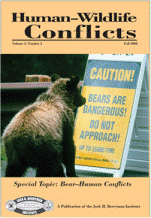Center, Internet, Wildlife Damage Management

Human–Wildlife Interactions
Date of this Version
2007
Document Type
Article
Abstract
Feral hogs (Sus scrofa) have recently expanded their range to include portions of the arid regions of the Chihuahuan Desert, Texas. We examined feral hog density, survival rates, range size, and habitat use in the Davis Mountains, Texas, to understand hog ecology in a desert environment. We tested the hypothesis that densities of feral hogs across Texas would be positively related to precipitation. Feral hog densities in the Chihuahuan Desert were low (0.65 individuals/km2), supporting our prediction. Annual home range sizes (100% minimum convex polygon) were also high and averaged 48.3 ± 4.4 km2 and 34.0 ± 4.4 km2 for males and females, respectively. Feral hogs exhibited a generalized use of habitats but preferred open-canopy, evergreen woodland. Annual survival rates for feral hogs were 0.86 (95% CI = 0.68-1.00). In the Chihuahuan Desert, feral hogs occurred in lower densities and had larger ranges than in more mesic environments. Efforts to control feral hogs in the Chihuahuan Desert should be concentrated on open-canopy, evergreen woodlands and sources of freestanding water.


Comments
Published in Human-Wildlife Conflicts Volume 1, Number 2, Pages 152–160, Fall 2007. Published and copyright by the Jack H. Berryman Institute. http://www.berrymaninstitute.org/journal/index.html